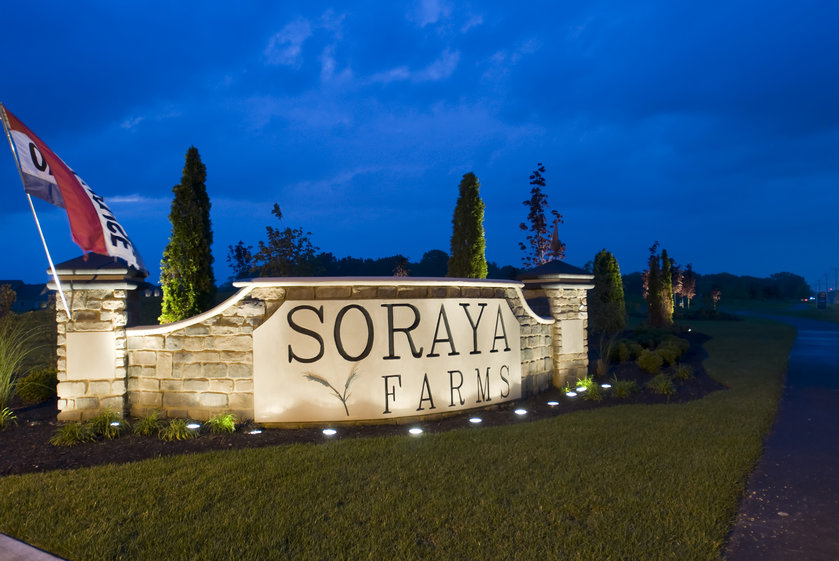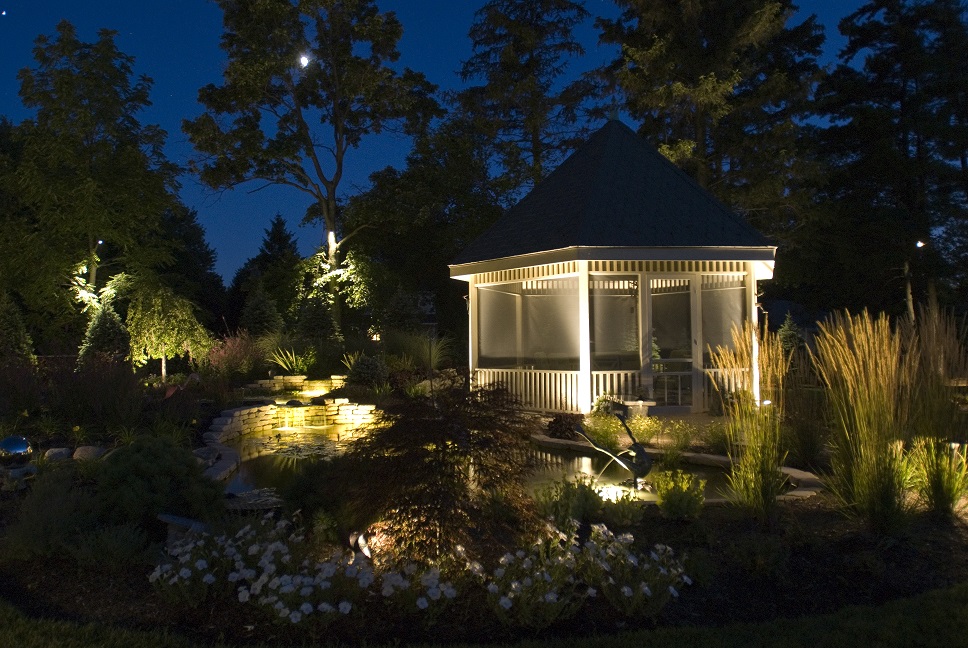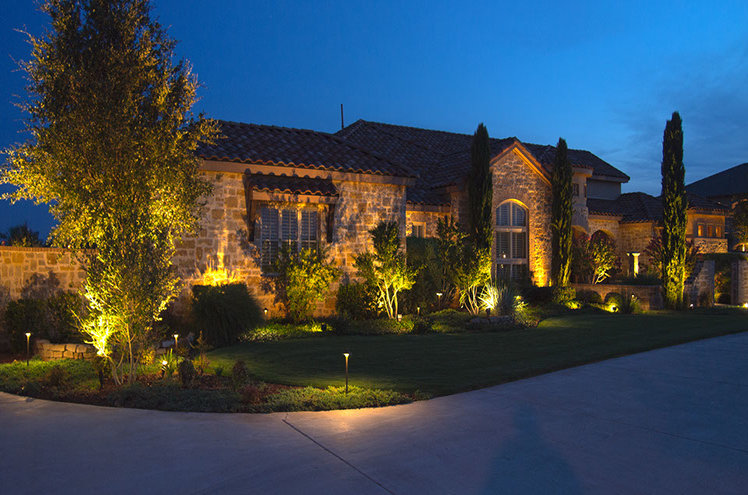Best 30 Do’s and Don’ts of Landscape Lighting Design
Updated June 26, 2023

The Best 30 Do’s and Don’t of Landscape Lighting Design
To help you create the best landscape lighting design for your property and backyard, our experienced landscape lighting experts have compiled a list of over 30 landscape lighting Do’s and Don’ts. We encourage you to read this list before planning your next design, making any purchases and installing any bulb, fixture or wire.
Why is this important?
Landscape lighting systems have become increasingly popular among homeowners. Think back to the last time you took a drive through any residential neighbourhood after dark. Chances are the majority of homes you passed by had some form of landscape lighting. This is because today’s landscape lighting systems provide homeowners with a wide variety of benefits. Sure, there’s the obvious aesthetic benefit of illuminating the unique architectural features of you home, but there are many other benefits as well. Some of these additional benefits include added safety, improved security and an increase in the overall value of your home.

With all these benefits provided by effective landscape lighting system, it’s no wonder that outdoor lighting has become a popular area for homeowners to focus on. However, if you do not have knowledge of current lighting design trends, techniques and best practices, you may end up with an ineffective and tacky-looking design. Worse yet, if you opt for a DIY installation, you could wind up creating potential safety hazards around your home and property.
Here is our list of Do’s for landscape Lighting:
Do install outdoor lighting
Many people spend a fortune on a beautiful landscape, only to have it shrouded in darkness come sunset. However, it’s the nightscape that creates some of the most dramatic effects on your yard, so don’t miss out on a beautiful landscaping opportunity!
An outdoor lighting system can increase the time you have to enjoy your beautiful property. What’s more, your landscape is often the first thing a visitor will see at your home, and as the saying goes, you only have one chance to make a great first impression. An outdoor lighting system will show your guests and neighbours that you care about your home’s appearance, both outside and inside.
Do use professionals to design and install your outdoor lighting system
You wouldn’t let an amateur build your house, so why would you trust your outdoor lighting to some hardware store clerk?
We’ve all been to a house where a poorly positioned spotlight blinds us as we pull into the driveway. Our Nite Time Décor experts can take that spotlight and reposition it so it showcases a portion of your landscaping (rather than startling your visitors!). A professional knows how to do things properly. They know how voltage works and how to work with it. Professionally installed outdoor lighting system is just that – a system. Not a haphazard spew of randomly placed lights.
Do use a variety of lights
Using the same kind of lights – same colour, same intensities – in all areas of your landscape lighting design will not help you achieve the aesthetic look you’re likely going for. Using the same lights across your whole system will make your landscape lighting design appear dull, flat and un-textured.
We recommend using a variety of lights that have different lighting angles, colours and intensities. This is not to say that you should use red, green and every colour under the rainbow, but rather that you should incorporate a variety of soft, warm colours throughout a number of areas around your home and property to create depth and ambiance.
Do use the right amount of fixtures
When it comes to the fixtures in your landscape lighting design, less is not always more. In fact, when homeowners try to cut costs by skimping on light fixtures, it often ends in disappointment. Sometimes, homeowners will opt to increase the brightness of their bulbs instead of purchasing and installing the appropriate amount of fixtures needed for their landscape lighting design. When this happens, it creates a stark contrast of extreme brightness and extreme darkness in your design. This is far from the ideal lighting style you are likely looking to achieve, and will act as more of a distraction than anything else.
If you are looking to cut costs, we recommend installing your landscape lighting system in phases or zones. Start by illuminating the area closest to your house and work your way out. This will help make the installation easier, less costly and will guarantee that each zone is illuminated in just the way you want it.
Do focus on your home
Before positioning outdoor landscape lighting around the natural features of your yard, light up your home. Highlight the walls of your house and the architectural features that make your home unique. This offers better security and safety, as well as a beautifully elegant backdrop for the rest of your outdoor lighting.
Do start by lighting the front elevation of your home
Starting your lighting at a higher elevation will help you set the balance of your lighting design. From there, you can move into smaller areas and focus on highlighting individual plants.
Do take your entire property into consideration
When installing garden lights, make sure that they mesh with the other fixtures in your landscape lighting design. A beautifully lit garden will look out of place if the rest of your property is under-lit or features few too many fixtures.
Do use lights to improve the safety of garden walkways
This will ensure that all areas, especially those that change levels (steps and stairs) receive the right level of lighting to prevent trips and falls.
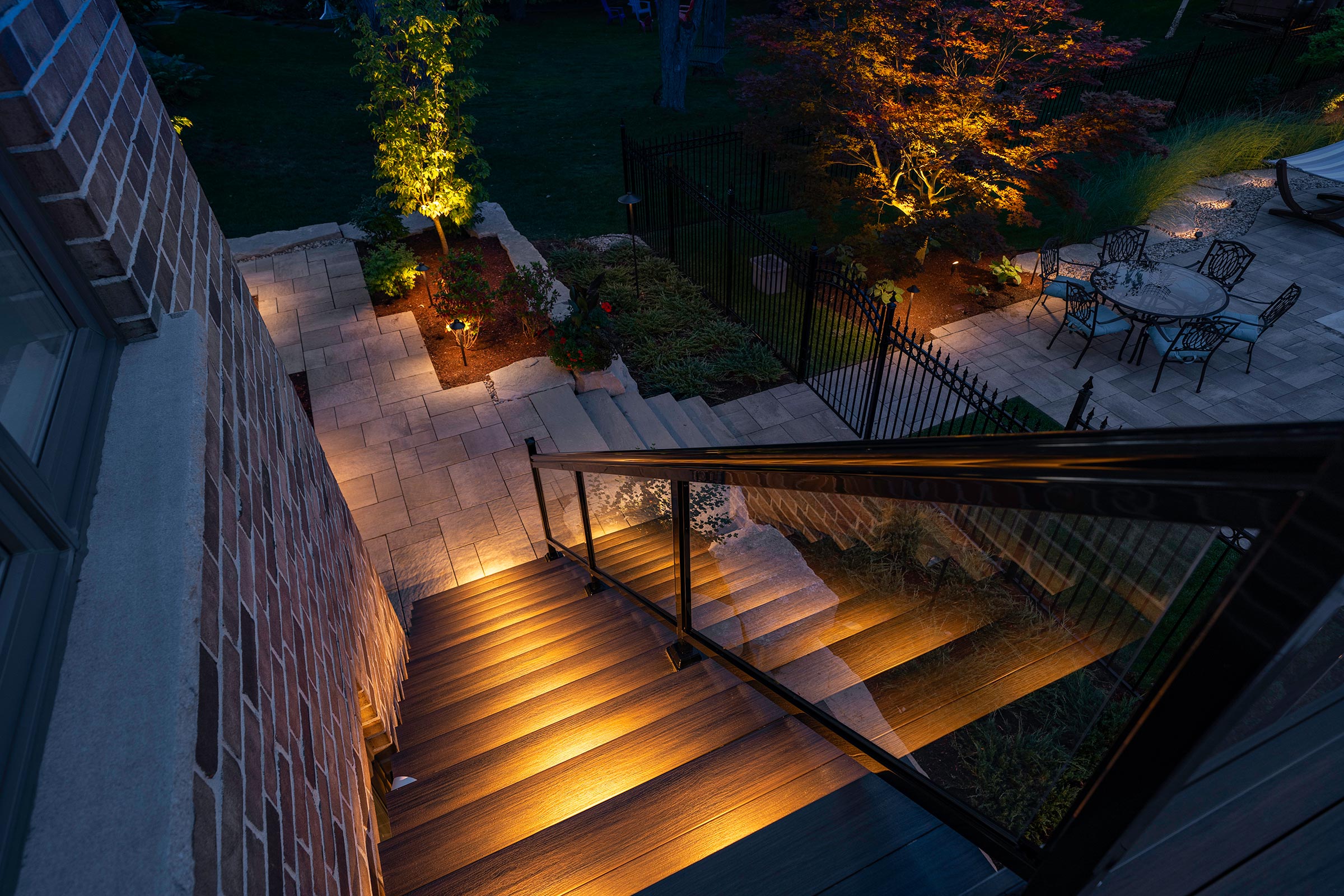
Do prevent glare
Use shields to ensure that the light from your Burlington landscape lighting system is properly directed.
Do make use of multiple layers
As with many other areas of design, complexity in layers adds beauty to the overall effect of your landscape lighting. Using layers in an area of lighting adds depth and three dimensions to your outdoor landscape lighting. For instance, positioning several spotlights from different angles against a statue can create silhouettes and layers to offer a detailed lighting effect, which would not have been accomplished with only one light.
Do illuminate shrubs and other areas to improve security
Shining a light on these areas will eliminate possible intrusion points and improve the overall safety of your garden and yard.
Do make use of uplighting for a natural look
The uplighting landscape lighting technique draws the eye upwards, giving the plants in your garden the illusion of size and grandeur.
Do down light pathways
Proper pathway lighting with down lighting are highly underrated, and also very rare. It’s difficult to find situations in which you can adjust your landscape lighting so that a path is lit from above. So, if you find the opportunity, take it. This is a gorgeous way to add illumination and safety, and has the added appeal of being uncommon in outdoor lighting.
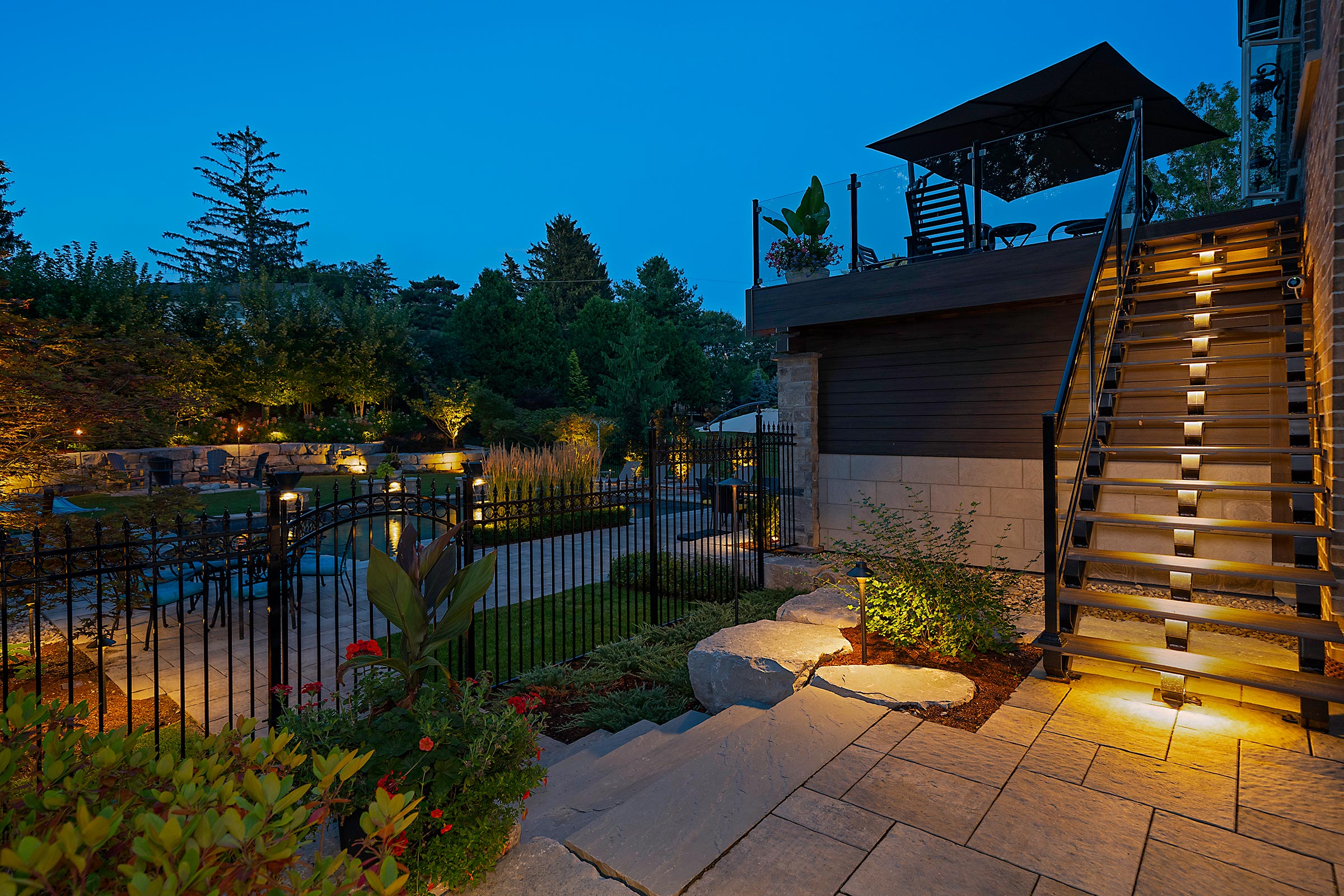
Do consider daylighting lighting options
When planning your garden lighting design, be sure to take dawn, dusk, and evening activities into consideration. This is when you’re most likely to be utilizing your garden for parties and social gatherings. Play with effects in these lighting situations in order to produce the perfect mood.
Do maintain your outdoor lighting
Just because your landscape lighting is installed, doesn’t mean you can forget it. For best results, regular cleaning and maintenance will be required.
For example, say you install our lovely area lights or tiki lamps and during one summer, there is a particularly violent windstorm. This could cause your lamps to be knocked out of alignment, causing the light to be splayed haphazardly throughout your yard. Or, after several years, maybe a light bulb burns out or electrical cords start creeping their way into view.
Luckily, professional landscape lighting installation companies are committed to providing you with quality customer service long after the installation has been completed. Visit our Service and Maintenance page for more information about how Nite Time Decor can continue to help you as the years go by.
Do consider LEDs from Nite Time Décor
LEDs are more than just the latest fad in trendy energy conservation. They really do the trick for offering beautiful outdoor landscape lighting while saving you money on your hydro bill. Though the initial start up cost appears pricey, the amount of money you’re saving in electricity more than makes up for it in the long term. Nite Time Décor has done the savings breakdown calculations on LEDs for you if you’re still not convinced.
Garden and landscape Lighting Don’ts – Be careful to avoid these mistakes:
Don’t forget the second story
While you’re figuring out how to light up your home, don’t forget to include the second story. With this, you’ll also want to include any peaks, pillars, overhangs, and other aspects that will look ethereal when illuminated above your lawn. Elevated lighting helps your lawn stand out in the night.
Don’t ignore small or dark spaces
Many homeowners focus purely on the larger, grandiose aspects of their landscaping. However, the small details are sometimes what can provide the loveliest accents to outdoor lighting.
Find the little areas in your garden that are easily forgotten, and offer them dignity in beauty through lighting. The benefit of this is also added security. When you light dark spaces, you create fewer holes for intruders to sneak through. Consider highlighting smaller features or areas of your garden in order to increase the “wow” factor of your design.
Don’t over illuminate
One of the major and most common mistakes that Nite Time Décor Oakville sees is the issue of over lighting. The beautiful thing about outdoor landscape lighting is that it doesn’t have to work hard to light up an ebony night.
Think of the moon and stars in the country – they are beautiful not because they ignite the brightness of the sun, but because they glitter and shimmer in a way that illuminates without blinding. Produce a similar effect with your landscape lighting design, and you’ll quickly leave the realm of airport tarmac and enter into an ethereal realm of splendour.
Don’t unintentionally create shadows
When you combine light without balance the result is unintentional shadowing. Lighting one area while leaving another in shadows doesn’t just look visually uneven, it will also reduce the safety and security of your property.
Don’t distract with light
Remember to direct light away from windows in order to reduce glare. Failure to do this could result in unwanted light reflections on your yard.
Don’t use low-powered lights
You may have created the perfect outdoor lighting design, measured it out diligently and perhaps even placed all the fixtures in the right places, but installing low-powered lights can cause any great design to fall flat.
With low-powered lights, the spread of your lights will be too weak to illuminate a large area, or the beam may only be able to light up a small portion of the object your trying to highlight.
To avoid low-powered lights, stay away from the cheap, low quality battery and solar-powered lights. Saving a buck or two may feel better on your wallet up front, but it will certainly cost you in the long run when you realize your outdoor lighting design is actually hurting your curb appeal.
Don’t be afraid to experiment
Use different wattages and beam spreads in order to create a truly unique lighting experience in your garden.
Don’t light for a runway
Countless numbers of homeowners make the mistake of lighting pathways and driveways with fixtures positioned in a straight line. This is boring, and tends to make your garden walk or driveway look like an airplane landing strip. Get creative with the placement – stagger the lights a bit to gain a more aesthetically pleasing outdoor lighting experience.
Don’t ignore limitations
Everything has its limits. When you’re choosing fixtures for your home, make sure to understand the limitations of both your home’s design, as well as the limitations of the fixture itself. Sometimes what you had envisioned for your home’s outdoor landscape lighting design just won’t work within the inherent boundaries of the architecture of your house. That’s okay: there are always solutions. And whatever solution you find is bound to look more beautiful for being perfectly tailored to the needs of your home.
Don’t isolate areas of your property
It can sometimes be difficult to decide what areas of your home and property are most important to include in your landscape lighting design. If you do not plan out your design correctly, you may end up isolating areas of your outdoor space. Take walkways and trees for example. These are common areas to illuminate in a landscape lighting design, however if you light up only these areas, and leave the surrounding areas completely unlit, you will isolate the space and create adverse effects.
To ensure you are not creating an extreme lighting contrast, we recommend incorporating other areas of the larger landscape into your outdoor lighting design. This can be as simple as placing lights in the plant beds and trees along the outer edge of your property.
Don’t forget your neighbours
In the dark, it’s easy to forget that your property is not isolated, and any addition of light can potentially affect the people next door. The form of light pollution caused by a glaring or unshielded outdoor lighting system is called light trespass. Not only will your neighbours find it annoying to have their sleep disturbed by your lights shining into a bedroom window, but it may also present a safety hazard if their steps and pathways are obscured by the glare from your home.
As you do your own thinking about the kind of lighting design you want, consider your neighbours with these tips:
Do aim before you fire
Every light should only illuminate the intended area and should never be directed along common lines of sight. When lights are improperly aimed, the resulting glare reduces rather than improves our eye’s ability to see at night and could cause danger.
Most fixtures you use should be adjustable, especially lights that are mounted at or above eye-level.
Lights that are vertically mounted, such as PAR lights and other types of spotlight should always be aimed at less than a 45 degree angle, and never straight out. While doing this, pay attention to the direction of the light and what other nearby areas might be affected.
Do shields up!
All good lighting designers will tell you: The thing to admire about a good lighting design is the effect it creates, and not the bulbs or fixtures used. If a bulb is clearly visible, then it is causing glare and it will throw light into unwanted areas, such as your neighbour’s yard.
Professionally designed fixtures that are intended for use in an outdoor lighting system will always be shielded. This allows for placement of the fixture in such a way that the beam can be accurately focused without exposing the bulb. It also prevents light from bleeding into surrounding areas. If your existing lighting uses an unshielded floodlight or other type of bulb, you can purchase shields to fit most sizes of fixture.
Don’t rely on solar lights
Solar lights may seem like a great, environmentally-conscious option in theory, but the fact is there are some downfall to using solar lights as well, and if you want to have a consistent and effective landscape lighting system, it’s best not to rely solely on solar lights. The main problem here comes from the inconsistency of the effectiveness of solar lighting. While they might work great in the summer months when the sun is shining bright for the majority of the day, you will see these lights perform 30-50 per cent less efficiently in the winter.
If you are looking for environmentally and energy-conscious ways to illuminate your outdoor space, we suggest using LED lights. LED lights use a fraction of the energy that hydrogen-based bulbs use and are reliable for use all year long. On top of that, LED lights also provide a wide variety of colour options to choose from.
Avoid making mistakes in your garden lighting design by planning your approach with a professional.
Do contact a professional
Whether you’re simply planning your next landscape lighting design, or you have a chosen design that’s ready to be installed, it’s best to contact a professional landscape lighting company.
At Nite Time Decor, our experienced team of landscape lighting professionals can help you design an outdoor lighting design that is perfectly suited to your home and property. We service homeowners and businesses throughout Hamilton, Halton, Burlington, Oakville and Mississauga, Ontario. Contact us today to get started!

